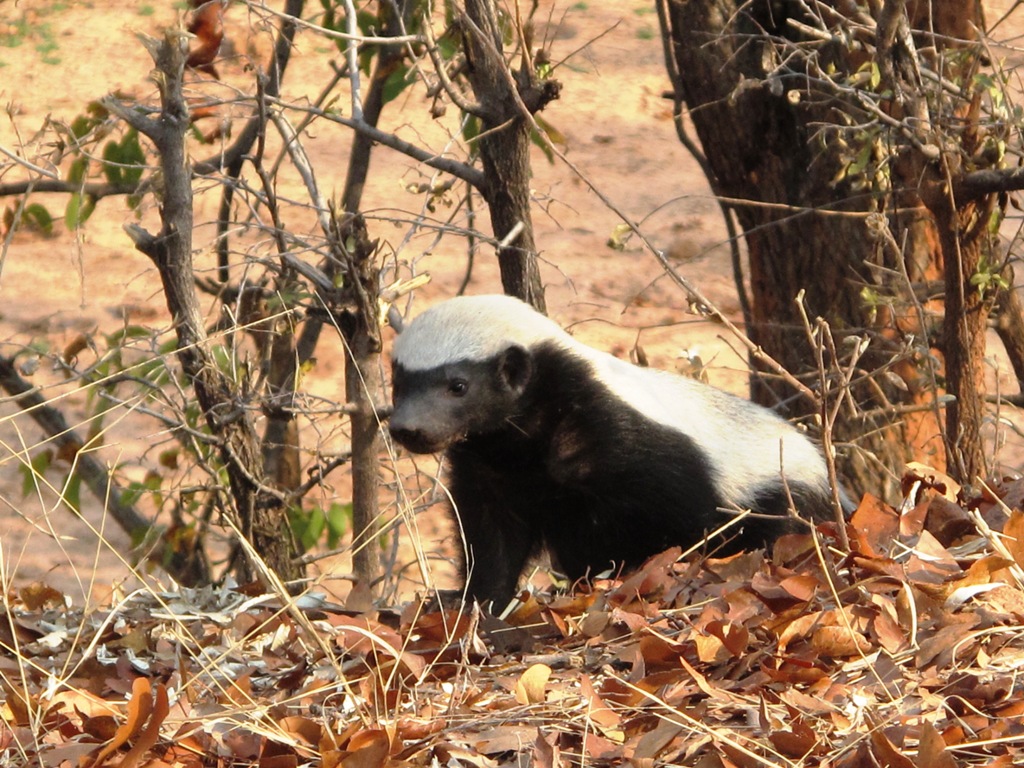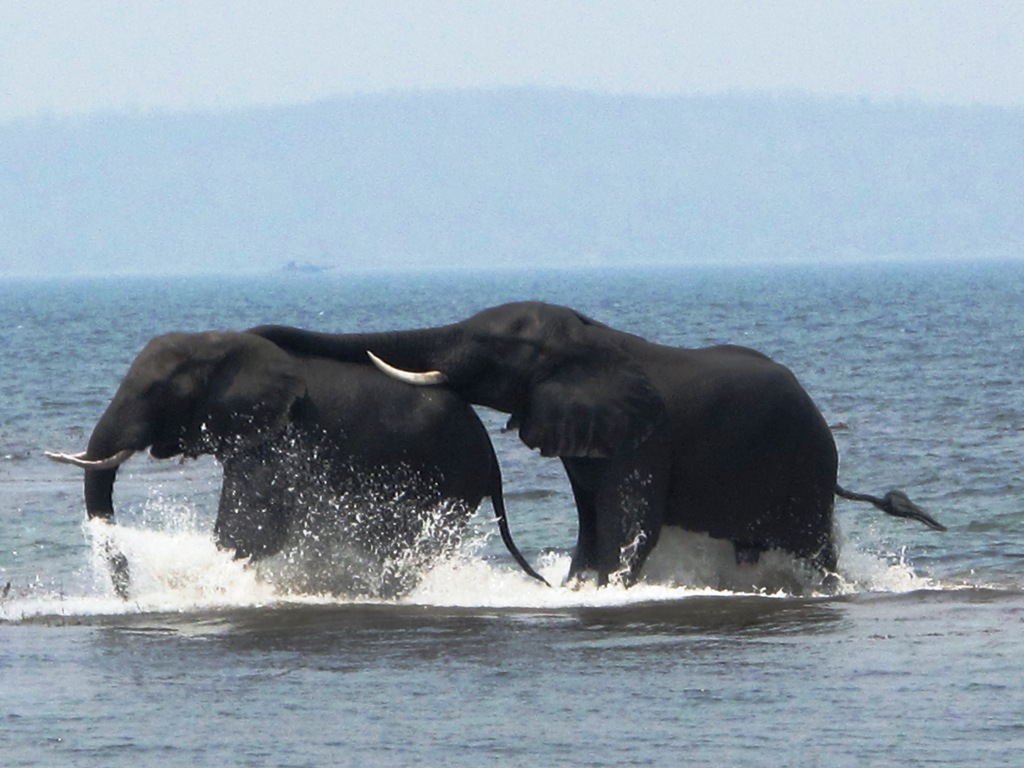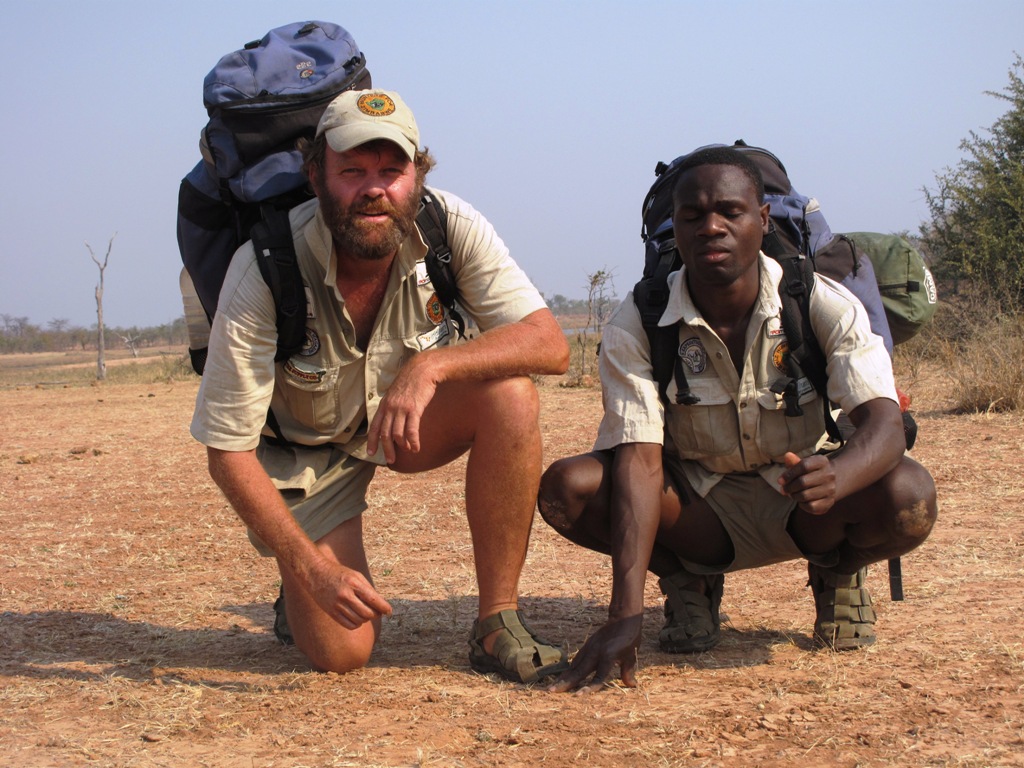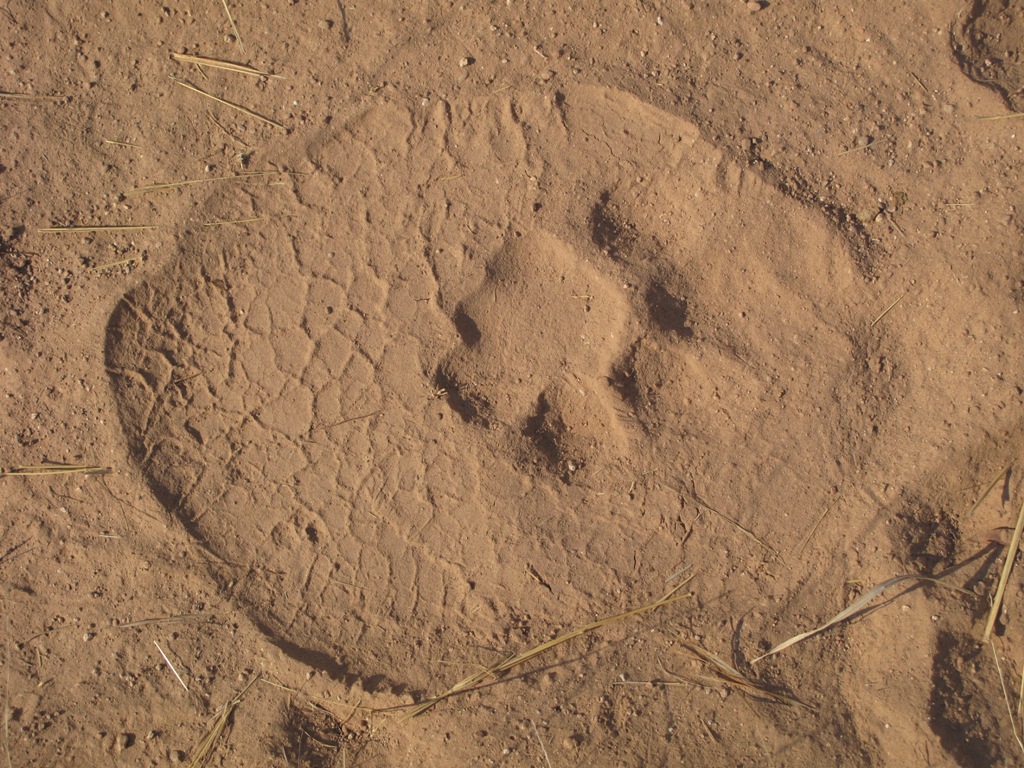We ended up spending a week at Tashinga before setting off for the Changachirere Parks post, which is the northern part of Matusadona, close to Spurwing Island. The walk took us two days and was a fantastic experience, although both of our minds spent much of the time elsewhere. We saw a great deal of game along the way – elephant and buffalo in the main, but some plains game too. Although we saw no lions or black rhino, we came across much fresh spoor of both species, especially that of lion.

At the end of our first day out from Tashinga, we camped on a low rise overlooking a scenic little bay about twelve kilometers shy of Changachirere. That night, lions sounded all around, for hours on end, not too far off. We got a huge fire going and lay prone in our tent, unable to sleep, for reasons unvoiced. We felt very small that night in that immense country. Eyes wide open.
Undoubtedly the most memorable moment of the walk from Tashinga to Changachirere was when we were charged by a honey-badger early the following morning. Fortunately it was a mock charge, but I didn’t realize this and after snapping off a couple of pictures, I turned tail and fled. Those who know the reputation of these fearsome little creatures would not blame me, I’m sure. Jephita had a good laugh at my flight and took up the honey-badger’s challenge bravely, emitting the same intimidating ggggggggggg sound as that of our attacker. Surprisingly, the honey badger backed down and went scampering off with tail aloft, back to his girlfriend who had not been interested in fighting. Maybe she didn’t approve and maybe he knew it, or else he was the most cowardly honey badger I have ever come across.
We arrived at Changachirere later in the day and were welcomed by the resident ranger, Timothy Tembo. After cooling off in the shade, abetted to a large extent by reviving cold water, Timothy paddled us over a short stretch of water to Spurwing Island, where we were treated to a slap-up feed and treated like royalty by the Spurwing lodge staff.
It was at Changachirere/Spurwing that I made the decision to put the Borderline Walk on hold for a while. The Umi boat disaster had set in motion a series of more minor misfortunes and both Jephita and I needed to get home to deal with various issues. Jephita had received a message that his cattle were dying from a mysterious disease, and I needed to sort out some financial affairs and see someone about intense metatarsal pain. We were supposed to break for a week or ten days, but due to further misfortune (Jephita got malaria and I got bitten by a spider), it would be almost a month before we got going again. This was a most frustrating time as we were so close to reaching a major milestone – Kariba town. Only about one hundred and thirty kilometers around the eastern basin separates Changachirere from Kariba, and we knew we could do it in a week, depending on how long it took us to find a ride across Sanyati Gorge, that is.
We were finally back on track on October 20th, hitching a ride on a houseboat from Kariba to Changachirere with referees from the Kariba international tiger-fishing tournament, which was due to get under way the following day. When we arrived at Changachirere, we were met by a stand in ranger who informed us that Timothy was in Kariba attending court proceedings. He and other rangers had been involved in a firefight with armed Zambian poachers the previous week, one of the poachers had been shot and grievously wounded, and the rest had surrendered.
The poachers’ impounded boat and motor were at Changachirere.
The borderline walk was underway again on October 22nd, and we tackled the eastern basin with enthusiasm, covering over thirty kilometers and almost reaching Sanyati west Parks post that day. It took us only an hour to reach the post the following morning, and we spent the rest of the day with rangers Golden Chitate and Thanks Chimbeya, whilst we consolidated for the challenge posed by the Sanyati Gorge and the rugged country surrounding it. Both Jephita and I were well pleased to be on the road again, and the fine company of Golden and Thanks served only to enhance our feelings of wellbeing. Who could fail to boost others with names like that eh?
It is only five kilometers from the Sanyati west Parks post to Sanyati Gorge itself, but the easiest route is still tough and it took us over two hours to get there. And then we waited, at a Parks observation point on a small bay just before the gorge, all the while looking out over the water for a passing boat. We didn’t see a vessel the entire morning, but as midday approached, so did a speedboat, coming from the direction we had. As the boat came into view, Jephita and I waved frantically and hollered loudly, and it immediately changed course, coming towards us. The occupants of the boat were good ol’ Zimbos – Pete and Liz Howson and Ron and Nancy Roper – and they were more than happy to give us a lift across the gorge. The name of the boat was ‘Chabweno’ which means ‘thanks’ in Chinyanja, and I thought how apt that name was. It was indeed a time to give thanks, for so many things.
Not only did the Howsons and Ropers lift us across Sanyati Gorge, they also gave us a great tour of that marvelous spectacle and plied us with cokes, fruit, etc. Sanyati Gorge is simply awesome – no other word will describe it as well. Pete Howson motored us a distance down the gorge to a most appealing spot hidden behind a bluff, and there he cut the motor and we bobbed about silently for a while, appreciating the splendor of the place. Pete explained that there was usually a waterfall cascading down the rocks at that point, but that it had dried up, being so late in the season. Waterfall or no waterfall, it is a stunning place.
As we were heading back towards the Sanyati mouth, we saw a small herd of elephants on the bank and Pete eased us in closer for a better view. Eventually, we were mere yards from the elephants which carried on feeding unperturbed. I was amazed by the size of those elephants – they were tiny, like dwarf elephants. It must have something to do with the vegetation in that area.
After a most enjoyable lunch hour, we were dropped on the Gache Gache side of the Sanyati and bade our kind transporters farewell. It was most difficult to turn down Liz Howson’s offer of lunch at Spurwing Island, but we were really behind time and had a lot of catching up to do.
Gache Gache was barren – not a sign of greenery except for right on the shoreline. We covered about ten kilometers that afternoon and arrived at the Gache Gache fishing village that evening, seeing a herd of about two hundred buffalo and a few impala along the way. The only game we saw was on the shoreline – hardly surprising as there can’t be anything to eat elsewhere.
At Gache Gache village, we were hosted in the quality manner we have become accustomed to by the sabhuku (headman), Mr Kapururira Limukani, and his children. Mr Limukani is a bachelor, his wife having sadly succumbed to cancer a couple of years ago, and he spoke of her for some time. It was not a depressing monologue, he was honoring the memory of his best friend, smiling and laughing often as he remembered the past. Mr Limukani scoffed and brushed aside my suggestion that maybe he should consider remarrying, saying he was far too old for that. Then he went back to reminiscing.
Wear your support
for Hunters against poaching in Zimbabwe!
CLICK ON THE IMAGE TO SELECT STYLE
Pick a cool T-Shirt and help support anti-poaching training in the Save Valley. PLEASE support HfZ now! Choose from men’s and ladies designs. Wear one t-shirt and carry the hopes of 10 million.
We arrived at Rod Ferreira’s Gache Gache hunting camp on the Gache Gache River at noon the following day, after a straightforward hike through mopani woodland close to the shoreline. Needless to say, the red carpet was rolled out. For some reason, we Borderline walkers never fail to be treated well by those we meet. It must have something to do with the country we live in, with the first-rate folk who populate it.

I had a chat with Rod about the way forward after lunch, once his clients had retired for a midday siesta. Rod’s advice was to break from the shoreline and cut inland to the Nyaodza River Bridge, about thirty kilometers off. This, he said, would ensure we did not pass through the Wafa Wafa military training camp which is situated on the lakeshore, around the Nyaodza mouth. The advice was sound and I took it. Rod then invited us to pitch tent at his camp that night, and tackle the haul to the Nyaodza the following morning, and I accepted gratefully.
That afternoon, I borrowed a fishing rod and went down to the river to try my luck. I caught six tiger fish but they were all small. As the sun set, just as I was about to give up, I hooked and landed a fish which must have weighed three or four pounds. Not a monster, but a great deal of fun.
The next day was the hottest we have experienced on the walk so far (40C+), and we covered what must have been close to a record daily haul on it, certainly in excess of thirty kilometers. Away from the shoreline, there is no water between the Gache Gache and the Nyaodza, and we set out that morning with eight liters, double what we usually carry. As it was, it was barely enough and we were down to our final few hot mouthfuls by the time we arrived on the Nyaodza at 1 p.m.
By that stage, both Jephita and I were suffering from pounding headaches and it was a huge relief to fill our bellies from a hole in the sand and flop down beneath a shady tree.
After lunch, Jephita fell asleep, and I went down to the riverbed to fill our water bottles and pour water over myself. As I was crouched to task, I heard a vehicle approaching, in low gear, up the riverbed, from the direction of Kariba. The driver of the vehicle turned out to be none other than my friend PH Ray Townsend, who was out and about hunting with his clients. I accepted the oranges, apples, cold water and advice as I always do – with a great deal of heartfelt thanks.
We camped that night at what we would later call Nyuchi (bee) camp, in the hills about five kilometers beyond the Nyaodza, closing in fast on Kariba town. As dawn broke the next morning, we began packing up camp, and shortly afterwards were attacked by a swarm of thirsty bees, intent on robbing us of the little water we had remaining. We beat a hasty departure, but not before receiving a number of painful stings. By 8 a.m. we were at the Charara banana estate, and by 10 a.m. were reclining on the lawn under a shady tree at the Charara fishing campsite, ice-cold cokes in hand. At 3 p.m. we set off for Kariba, cutting through the bush to the power-lines and following them into town. We finally made our legitimate entrance into Kariba town at sunset on October 27th.
It is now November 2nd and we will be heading out from Kariba early tomorrow morning, to tackle the lower valley – Kariba to Kanyemba, the third stage, if you will. We are most excited about this forthcoming stage. Although the distance to be covered fits into what we have already done almost three times, there is no doubt that Kariba to Kanyemba is going to be stimulating. Besides the obvious (Umi disaster and forced delays), the Borderline Walk has already been so much more than I ever could have imagined.
Although we have only completed 15% of the total distance, have suffered huge setbacks and are way behind time, the positives far outweigh the negatives. Unfortunately, it is impossible to tell all in the short articles I write, and if not quite the tip of the iceberg, then what you are reading is certainly condensed significantly. One day the whole story will be written, that I promise.
We have ended up spending some time in Kariba town, both during the time we pulled out for a break and right now, whilst we prepare for the lower valley. Kariba is a most interesting town and we have been fortunate enough to have been given a series of tours by various locals. I have also been fortunate enough to meet a man I have admired from afar for many years – Mr Dolph Sasseen. Dolph worked for National Parks for many years and is an incomparable bush man, specializing in anti-poaching. He is currently contracted to National Parks and is training Zambezi Valley rangers in the art of bushcraft.
A couple of days ago, I met a most interesting and adventurous man named Andries Scholtz. Andries is a Kariba stalwart involved in….Well, everything under the sun, it seems. And there is plenty of that in Kariba – sun, that is. Bush camps for children, survival courses, conservation, scuba-diving, sailing, hotel and boat construction….there is no end to Andries Scholtz. Unfortunately, I met Andries too late and do not have enough time to take him up on his offers of accompanying him on various adventurous excursions. But I have promised to take another break from the walk at some stage, and join him for a few days scuba diving and yachting.
Life is fairly cheap here on the dam. From Mlibizi to Kariba we have heard over a dozen reports of people who have been killed within a day or two of our arrival at a particular place, by crocodiles, hippos, elephants or drowning.
Only two days ago, a man was taken by a croc close to the Lake Harvest depot here in town, and a few days before that a man was trampled by an elephant within the town limits.
The residents of Gache Gache are all up in arms (understandably) about the hippos, which have killed eight fishermen in a year, or so we were told. What I find astounding, insofar as the crocodile related deaths are concerned, is that people keep going back for more. Time and again the crocodile strikes, at the same place it struck before, and at the same place it will strike in a couple weeks time. Change your washing location people!
Somewhere between Binga and Kariba, at a site that may or may not be publicly disclosed, Jephita and I discovered what we are sure to be dinosaur bone fossils. Certainly they are bone fossils and I cannot think of any creature other than a dinosaur that has been around long enough to be fossilized. Yes, they are still around and Kariba dam is full of them – scaly, ugly and dangerous. In any case, we believe we have found a dinosaur fossil site, just to give you all something to ponder. Those who should be told have been.
I hope to be able to post another report from Kanyemba but am not sure if it will be possible. You will, however, read about the Kariba/Kanyemba stage as soon as I am able to type it and track down someone with broadband.


